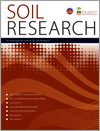SR20138Effects of plant invaders on rhizosphere microbial attributes depend on plant identity and growth stage
 , Ioannis Topalis, Dylan Gwynn-Jones, Urania Menkissoglu-Spiroudi, George P. Stamou and Efimia M. Papatheodorou
, Ioannis Topalis, Dylan Gwynn-Jones, Urania Menkissoglu-Spiroudi, George P. Stamou and Efimia M. Papatheodorou
Biological invasions are considered a serious threat to natural ecosystems. Considering that soil biota play vital roles in shaping plant communities and the functioning of terrestrial ecosystems more attention must be shown to assessing invasion impacts on soil biota. This study showed that invasive plant species partly mediated plant–soil interaction during their life cycle. Understanding the effects of invasive species could significantly help reduce invasive species infestation and increase the success of restoration projects in disturbed areas.




